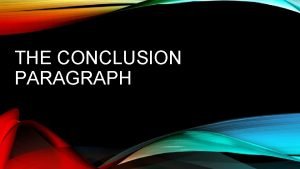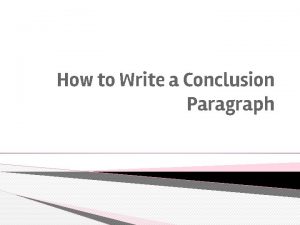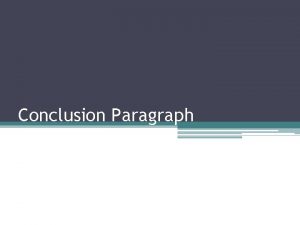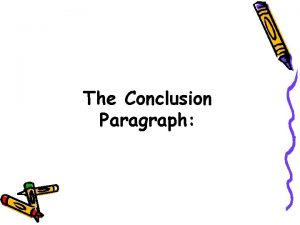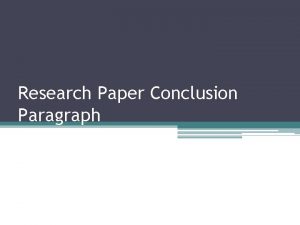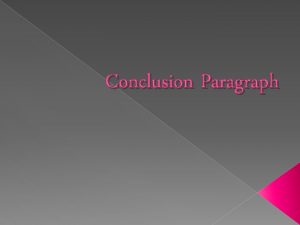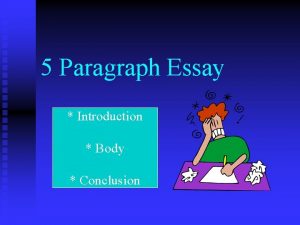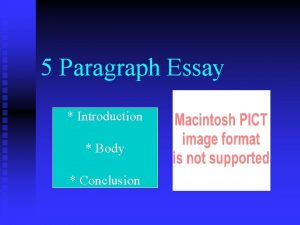The Conclusion Paragraph The conclusion paragraph in an











- Slides: 11

The Conclusion Paragraph

The conclusion paragraph in an essay of literary analysis functions as follows: It finishes off the essay and tells the reader where the writer has brought them. p It restates thesis and contains echoes of the introduction and body paragraphs without listing the points covered in the essay. p It creates a broader implication of the ideas discussed answers the questions: so what? Or why do we care? p

Anatomy of the Conclusion: p p The conclusion begins with a restatement of thesis, not a repetition, and gradually widens toward a final , broad statement of implication. Borrows from the body paragraphs, without being flatly repetitive or listing points already covered. Creates echoes of the introduction and body paragraphs to reinforce analysis/ ideas. Moves outward with a statement that relates thesis to a broader implication so the reader can see the analytical focus in a larger perspective or application.

Strategies for Composing Conclusions: Strike a note of hope or despair. p Give a symbolic or powerful detail/fact. p Create an analogy that relates your topic to a larger implication. p Give an especially compelling example. p Use a meaningful quotation. (If you used a meaningful quotation in your introduction, refer back to this quote and tie it in with your overall analysis. ) p

Recommend a course of action without being “preachy. ” p Echo the language and approach of the introduction. p Reference and make meaning of the title of the work you are analyzing. p

Consider the following checklist when writing a conclusion: Avoid first-person point of view, abstract/vague language, poor diction, and slang. p Avoid simply repeating thesis and/or listing the main points. p Don’t conclude more than you reasonably can from the evidence you have presented. p Echo the language and ideas from your introduction and body paragraphs. p

p p Expand on the implications of your analysis: So what? Why do we care about these ideas? What’s so important about what you’ve developed in your paper? Are there any other applications for your ideas? Avoid any attempts at humor, cuteness, or sarcasm. The conclusion need not be longer than four to six sentences, as with the introduction, but must be adequately developed. Include the title(s) and author(s) once more.

Sample Conclusions: Evaluate the strengths and weaknesses of the sample conclusions to follow. p Identify possible references to thesis statements, introduction, and body paragraphs. p Identify broader implications. p Identify and evaluate other strategies used. p

Sample 1: Edna’s character transforms from sleeping through life by meeting expectations to a great awakening, in which her thoughts and actions are consistent with each other. Edna’s struggle between her inner desires and her outward conformity is one in which her best solution was to satisfy no roles and expectations, including her own. Her character is so memorable because the reader can empathize with Edna’s internal conflict to both conform and defy. She is unforgettable because she does what each of us has wanted to do; her character resonates with the universal human condition of defying and abandoning societal expectations and impositions.

Sample 2: Throughout Morrison’s Beloved memory has a power distinguished from other motifs in the novel. Memory is so pervasive that it functions as a separate character within the plot. It interacts with, and has a unique relationship with, each character; it brings up painful past experiences, and preys upon those resonances. Indeed, memory functions as an additional antagonist, dredging up the past, teasing and torturing without remorse the characters who attempt to forget. Ultimately, however, memory is defeated with Morrison’s dictate: “this is not a story to pass on. ”

Sample 3: The values of leadership portrayed by Tamburlaine’s character are still honored in society today. We desire a leader who is passionate and eloquent, but who is a leader of action, as well. We also value a leader who is proud and confident in his or her abilities and experience. Today’s leader’s would do well to consult Marlowe’s example of leadership in Tamburlaine.











